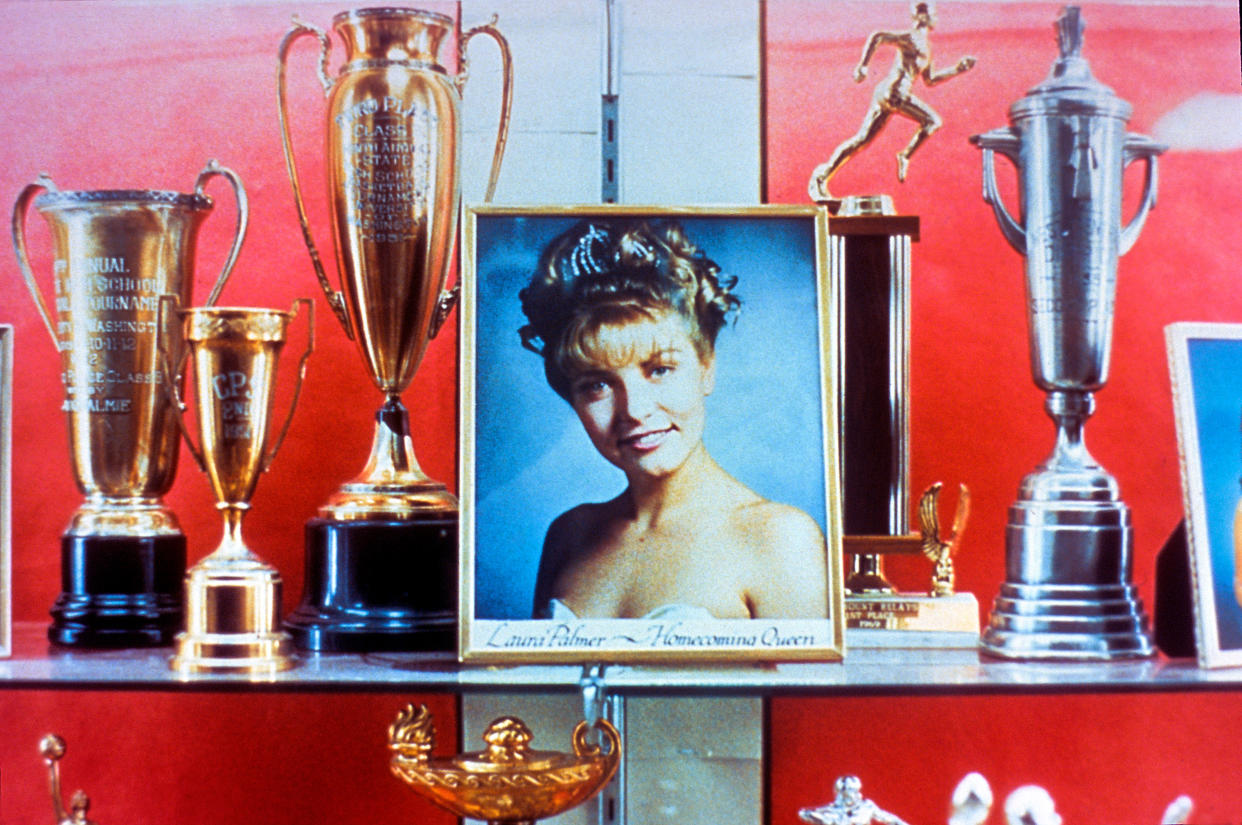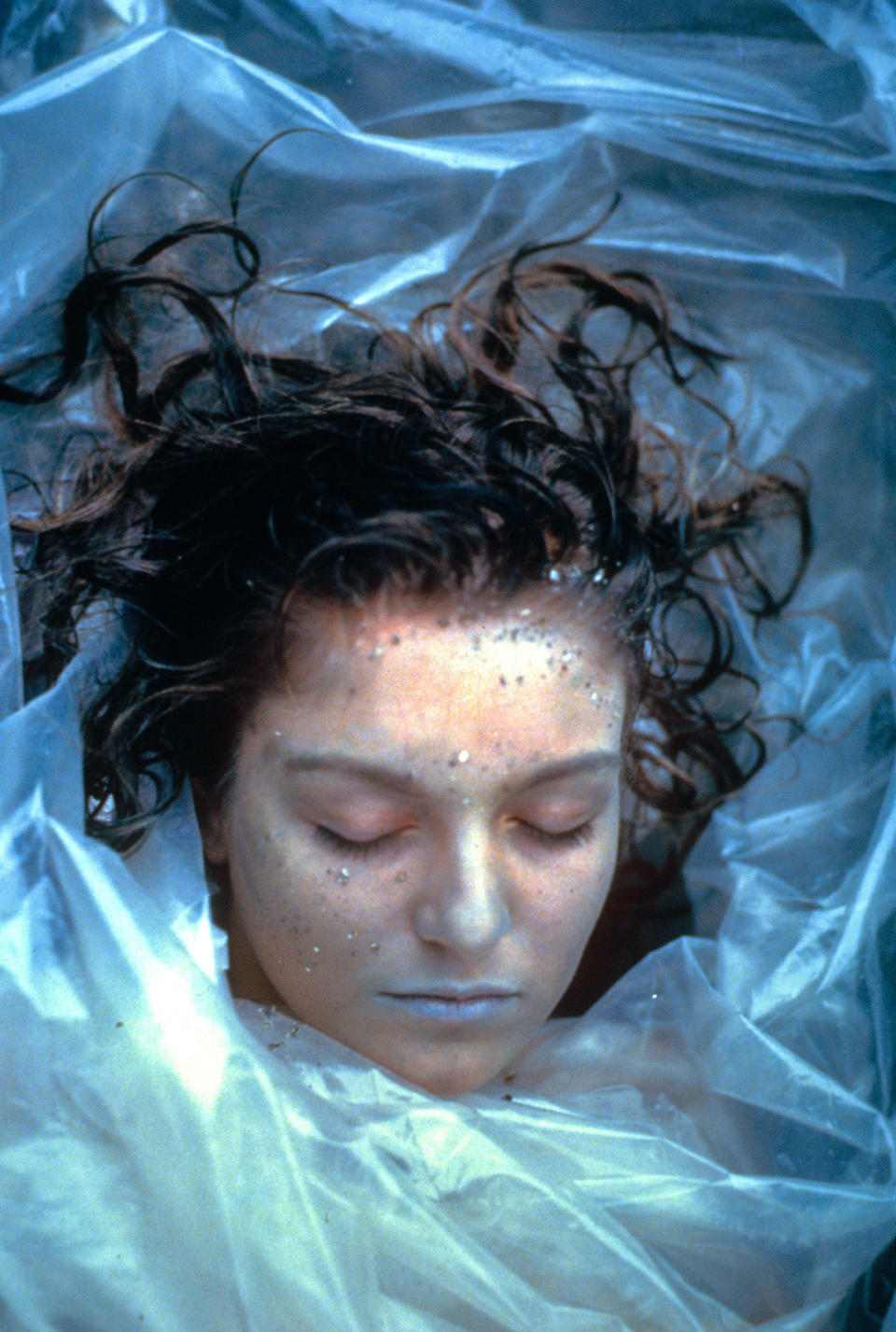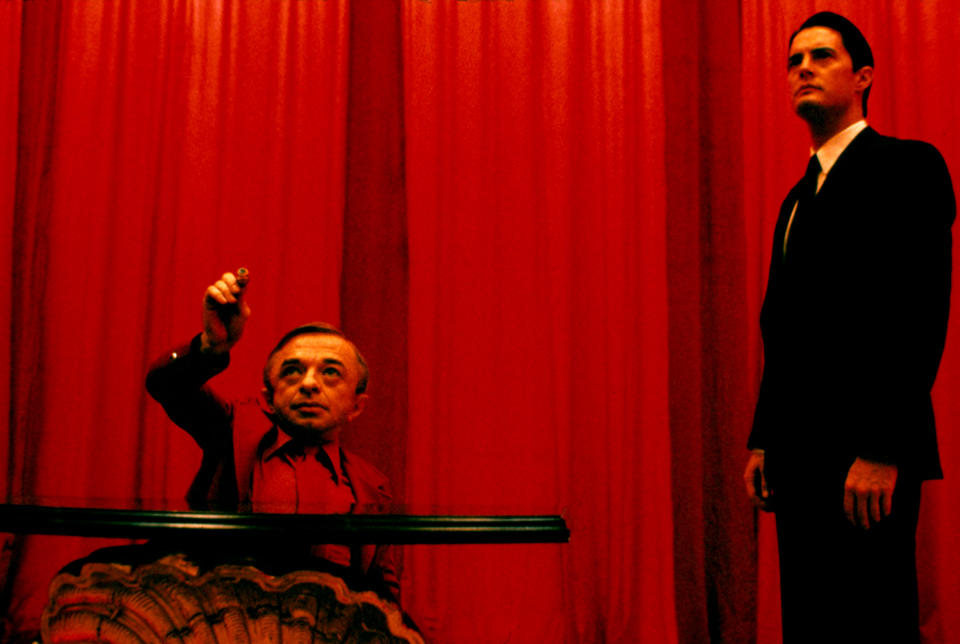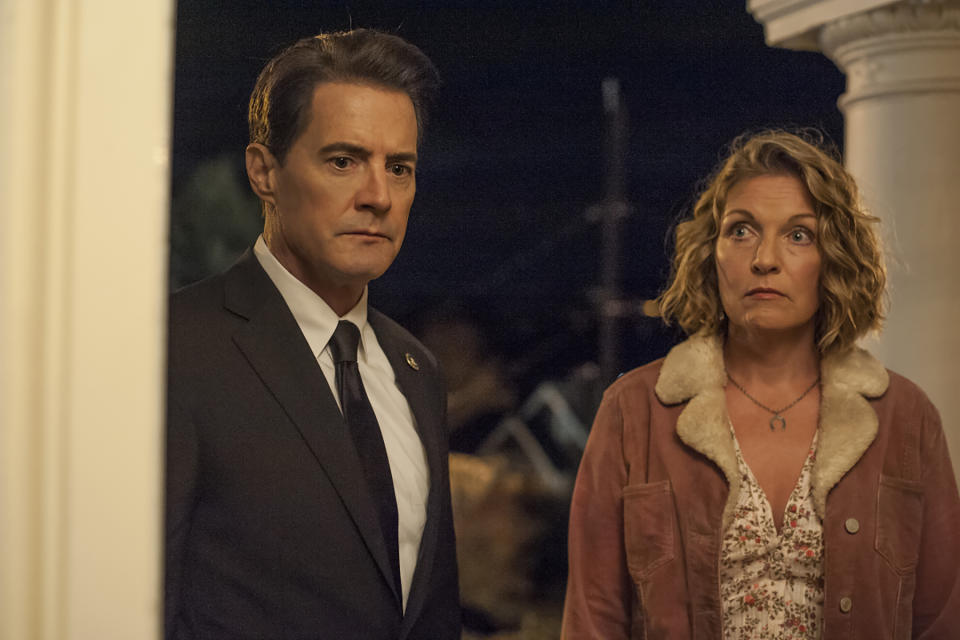'Twin Peaks' at 30: An oral history of how Laura Palmer's story began... and ended

Sheryl Lee, who played the show’s central victim, and Mark Frost, who co-created the surreal mystery series with David Lynch, revisit the classic show, from casting to unlikely success to The Return.
Twin Peaks wasn’t supposed to last one year... let alone 30. When David Lynch and Mark Frost delivered the pilot for their groundbreaking TV series to ABC three decades ago, the network executives were collectively confounded. “They were utterly baffled,” Frost tells Yahoo Entertainment now. “I know there were a couple people who were saying, ‘This is will kill us. We'll be the shame of the television industry.’”
But then something happened that surprised ABC’s top brass, including a young Bob Iger, still years away from his legendary tenure at the Walt Disney Company: Test audiences loved it. “They got such a good response to the pilot that they didn’t anticipate,” Frost recalls. “If that hadn't happened, there's probably no way they would have ever proceeded with putting it on the air. But it blew away their expectations, and Bob recognized we had something different. At that point, ABC was a distant third place in the ratings, so they didn’t really have anything to lose and the naysayers were quietly told to shut up.”
Even with test audience approval and critical raves, the network still had no idea how Twin Peaks was going to be received by the public at large when it premiered on April 8, 1990. They needn’t have worried: The show was an instant smash hit, an experience that Frost now compares to a “Roman candle going off.” Audiences couldn’t get enough of the titular Pacific Northwest town and the tragic mystery at its center: Who killed Laura Palmer? Sheryl Lee played the show’s victim whose short life and violent death is the beating heart of Twin Peaks. “I didn’t have any film or television experience prior to that,” the actress tells us. “For me, it was wonderful because I got to learn like a sponge, just soaking it all up.”
In separate conversations, Frost and Lee provided a revealing oral history of the show’s three-decade run, from the discovery of Laura’s body in the opening scenes of the pilot — one of the most famous sequences in TV history — to the chilling closing moments of the 2017 revival series, Twin Peaks: The Return.
Sheryl Lee: I was living in Seattle studying theater, and I got a call from my agent that David Lynch was in town shooting something for TV — it was very mysterious — and there was a role of a dead girl that he wanted to meet me about. I went and met him and Mark Frost and I was very intimidated, but he was so kind and warm. He just talked to me and put me at ease and told me about being wrapped in plastic, put in freezing cold water and painted grey. I said, “That all sounds fine!”
Mark Frost: I remember when David and I met with Sheryl, we had just seen a headshot and were looking for a very particular kind of look: the all-American girl next door who everybody in town had feelings for. She fit the bill perfectly, and had such a wonderful, sweet personality, we both just thought she was perfect.
Lee: When I got to set, I don’t remember specific conversations as much as the way that both Mark and David make one feel welcome and safe emotionally. They’re so clear in their vision and both so kind and warm to be around. Even though I’m a total introvert by nature, they create such a wonderful environment along with the other people they hire.
Frost: If we didn’t shoot the discovery of Laura’s body on the first day, it was definitely one of the first few days. And you just knew watching that first scene come together that it was going to have an impact. We wanted to get right into it — that's what lights the fuse, so that felt like the best way to begin the story.
Lee: I remember it being an all-day shoot. I was actually wrapped up, so I had to have people carry me up to the holding area in order to get unwrapped to move around. But David is such an artist, and was really involved in the image that was created, whether it was folding the plastic or placing the sand grains on my face. He’s an artist in every sense of the word in all these different mediums, and they all come together in this really beautiful way. For myself, I knew that I needed to go into the deepest state of relaxation — almost like meditation. I knew that I needed to slow my system down because the camera’s looking at you, so you don’t want to be fidgeting or breathing too fast. I just really worked on my state of being, or non-being!

Frost: We had all the Season 1 scripts written before we shot. It was a peculiar set of circumstances: ABC commissioned the pilot, but they kept delaying when they were going to air it. They got such a good response that they didn't really anticipate to the pilot during test screenings, so they decided, “OK, let's go ahead and have them have it all mapped out.” So we were able to shoot the next seven episodes with the luxury of having them all in front of us. It was easier for me to chart all the narratives and create all the ties between characters and plots and storylines and to flesh out what was one of the largest ensemble casts that anyone had ever seen in a network show. We had 35 to 50 people that we were working with as part of the story, so that took a lot of planning and a lot of forethought. To have that all done before we rolled cameras on Episode 2 was a huge advantage.
Lee: When they finished shooting the pilot [in Washington], they went back to L.A. My character was dead, so I stayed in Seattle to do theater. Months later, David called me about the possibility of moving to L.A. Even then he didn’t say anything specific about my role: He just talked to me about more involvement in the show. At that point, I was like, “I’ll say yes to anything he asks me to work on.” He let it evolve naturally and organically.
Frost: The Red Room came about because when David did the pilot, our foreign distributor wanted to have a closed ending that they could release as a feature in Europe in case the show didn’t get picked up for a series. So it was that scene that led to the discovery of Bob, the phrase "fire walk with me,” and the first time we saw Michael J. Anderson as well. We had written the sequence into the second episode, and David’s visualization of it became one of the most iconic images in television history.

Lee: I love the creative challenge of working in the Red Room; it’s completely different from any other set. It’s almost like I have to leave the logical part of my brain at the door when I walk on that set behind those curtains. It is, in a way, like working in a dream world where time and logic are stretched. It’s like working in a different dimension honestly, doing everything we do in there. If I overthink it, I get in my own way. That’s the greatest lesson I’ve learned from David: staying present in the moment as an artist and an actress, and how that opens up the door for possibility.
Frost: I can't remember the origins of the “But sometimes my arms bend back” line. It might have been a reference to the fact that there was a statue in the room that didn’t have arms. Or it could have been a reference to something that happened to her before she died — that her arms were bent back, because she was actually being kidnapped or hurt. There were a number of different ways you could think about it, but we didn't want to say it was just one at the expense of all the others. All of that dialogue was written: David wanted to build a certain number of puzzles into the scene, but there was an underlying logic to all of it that we just never really talked about. We just wanted to let people experience it and discover it for themselves. We discovered it's more fun for an audience — or at least our audience — if you don't hit them over the head with it, and let them be part of the process.
Lee: When I originally started on the show, I was 20 or 21 and I was living inside Laura’s story in terms of playing her. As I’ve gotten older, fans who were survivors of sexual abuse or incest would share their stories with me in terms of the impact or connection that Laura’s character had on them. Even though I knew that was her story, I didn’t realize until it started happening how that was reaching out into the culture. That’s the part that means the most to me. Thirty years later, the statistics of how often this happens in real life are not going down. So what can we do? What can all of us do? Because it’s going to take all of us to change this and heal this and protect the innocent. I give such incredible respect to Mark and David for writing that when no one else was. They dared to tell a story like that at that time and started a conversation.
Frost: Twin Peaks is the story of a terrible tragedy and one that’s all too common that hadn’t really been depicted in quite this way on network television. We didn't tell [ABC] what it was originally, because they probably would have killed it right away if they'd known what was actually going on. But these were adult themes, and these were real events and they had huge impact on people's lives. So it affected everything: It affected performance, it affected the intensity and the feeling that it created. Also, in that pilot, the intense feeling of grief that dominates the first half hour is pretty immersive. It pulls you into a world where all these people are reeling and in pain and confusion, and people just seem to want to go there. They wanted to know what happened, they wanted to see how it was going to resolve, and they wanted to pursue the mystery. So we just made sure the mystery was full of twists and turns, deep dark secrets, and, in the end, very real and tragic.
With Season 2, once we'd solved the mystery — which neither of us particularly wanted to do, but the network was then insisting on it — we had to jump into a whole other idea that took a little time to set up. We didn't have the luxury of the opening that we'd had at the beginning of the death of Laura triggering everything. And then the thing that really hurt us was we were preempted for six out of eight weeks when the Gulf War started. Every night everybody was watching reporters standing in front of bombs falling in Baghdad, and this was not a show that benefited from people not seeing it for six weeks. But I don't think there's anything that people can quibble about the show through the first half of the second season. The first nine or so are incredibly strong, and built an intensity and power that I think really worked. I always felt that if enough time went by those things would be reappraised and they have been. I think people now see it more as a continuum rather than an aberration.
Lee: Making the movie, Fire Walk With Me, was a huge relief because I felt as if Laura had something to say that she hadn’t gotten to say. I don’t know how else to explain it other than that, and I’m very grateful that David gave her the opportunity to share her story in that way. There was a deep relief of “OK, she gets to have her voice heard.”
Frost: I wasn't involved with Fire Walk With Me, because I was directing a movie [1992’s Storyville] myself at the time. So I told David, “Go ahead.” He was basically planning to adapt The Diary of Laura Palmer, which Jennifer Lynch had written under my guidance from a storytelling standpoint. That was really rich source material, and David said, “Look, I want to go back and tell the story.” I said, “My instinct would be to go forward, and tell the story from where we left off, but if you want to do that, go right ahead.” So that's where he went off to make that movie while I was making mine.
Lee: I started hearing a bunch or rumors [about a revival] and thought it was just a joke. Then another cast member texted me that this one wasn’t a rumor. I reached out to David and said, “Is it true?” At first I didn’t assume that I was going to be a part of it, and then I didn’t assume that I was going to be Laura again. I’ve learned from working with him not to make any assumptions!

Frost: I first reached out to David about The Return in 2012, but we didn’t tell anybody — not even our wives. We talked about it without writing a word for almost a year, and then we felt that we were ready to commit stuff to paper. We wrote the first two hours in early 2014, and showed it to Showtime. After that, we were off and running. We didn’t write episodes: We wrote one long script and said, “It’s going to be as long as it needs to be.” The last thing we wanted was to make our version of The Harlem Globetrotters on Gilligan's Island. That would be worst case scenario. The Return needed to be its own thing:
It needed to be uncompromising, and much more modern in its intent and feel, while also respectful of the time that had passed.
Lee: I don’t want to say too much about the final scene, because I want fans to have the freedom to have their own theories. I will say that shooting that scene was really trippy and chilling. It was in the middle of the night out there in front of that house all these years later, and the ambience was such a huge part of that scene. I’ll never forget how I felt when Agent Cooper says, “What year is it?” I have heard nothing about whether or not they’ll be any more than this. I wish there was, but I’m not holding my breath.
Frost: It felt like the right place to end it, given that Cooper had kind of defied the rules to try to undo a terrible wrong, but ended up paying a terrible price himself. In terms of making more Twin Peaks, I never say never. Who would have expected us to come back when we did? That being said, I think The Return stands on its own really effectively, and we’ll just have to wait and see.
The first two seasons of Twin Peaks are currently streaming on Netflix and Hulu; Twin Peaks: The Return is available on Hulu with a Showtime add-on.
Read more from Yahoo Entertainment:
Want daily pop culture news delivered to your inbox? Sign up here for Yahoo Entertainment & Lifestyle's newsletter.


